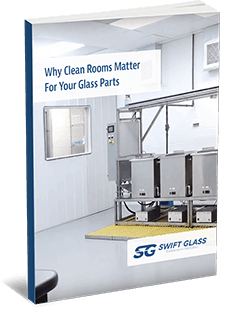The Six Most Common Contaminants a Clean Room Removes
The manufacture of sensitive components, such as electronics, fabricated glass, and pharmaceuticals—necessitates the use of clean rooms. These structures establish an enclosed and controlled environment that minimizes contamination that can negatively affect the quality or integrity of manufactured products and productivity of a facility. For glass fabrication applications, cleanliness of the workspace is particularly critical, as even the smallest particulates can result in manufacturing errors, downtime, and costly cleanup efforts.
Clean rooms serve as the perfect solution to these issues as they employ high-performance filters that collect and remove a wide range of contaminants from the work environment. The following blog post outlines six of the most common types of contaminants for which clean rooms are used to remove.
Top Six Contaminants Clean Rooms Remove
Industry professionals employ clean room facilities to reduce the risk of product or process contamination from a variety of compounds. Six of the most common types and/or sources of contaminants are:
1. Airborne Fibers
Due to their small size, covering a large surface area, airborne fibers can significantly affect manufacturing processes. These qualities can result in physical and chemical issues stemming from electrostatic attraction and reaction with other substances.
2. Process Liquids
Many manufacturing processes require the use of process liquids, such as water or other chemicals. Since anything entering a clean room can potentially cause contamination, these substances must be specially purified and transported in clean, non-corrosive containers. It is particularly important for water to be purified, as it is often used to clean and rinse equipment.
3. Process Gases
Process gases also play a role in manufacturing applications. Similarly to water, these substances must be properly filtered to reduce the risk of contaminating a part or process. Additionally, when selecting a process gas, industry professionals must consider any potential reactions between the gas and other objects within the clean room.
4. Small Particulates
Small particles demonstrate Brownian motion, meaning that they float for long periods of time and move unpredictably. Fortunately, high-efficiency particle attenuation (HEPA) filters remove 99.99+% of these particles. The remaining particles collide with each other until they become large enough to be removed via other means.
5. Production Personnel
Employees serve as the source for 75–80% of the total particles found in clean rooms. They introduce some contaminants from their skin and hair and bring in others through their clothing and cosmetic and skincare products.
6. Production Facility
The facility itself can introduce contamination in the form of debris, dust, dirt, and construction materials. Contaminants can also enter through air conditioning systems and faulty equipment and components.
How Does Swift Glass Minimize Clean Room Contamination?
 At Swift Glass, our ISO Class 7 clean room allows us to produce high-quality glass products suitable for use in sensitive applications. We ensure that every product we deliver is contaminant-free by employing the following:
At Swift Glass, our ISO Class 7 clean room allows us to produce high-quality glass products suitable for use in sensitive applications. We ensure that every product we deliver is contaminant-free by employing the following:
- HEPA filters. HEPA filters can significantly reduce clean room contamination, filtering particles as small as 0.3 microns. We may also use them in conjunction with secondary filtration systems for more effective contaminant filtration.
- Optimized clean room architecture. Our clean rooms are also designed for better airflow, which prevents particles from settling and collecting on surfaces. Features such as recessed lighting, covered light switches, and specialized furniture also help prevent the buildup of contaminants.
- Rigorous clean room protocols. We enforce a strict dress code and procedure to prevent staff from tracking contaminants into the clean room. This can include dressing in protective clothing such as gowns, gloves, masks, goggles, and hoods, using shoe coverings that are cleaned before entering the facility, passing through air showers, not wearing personal cosmetics or skincare products, and bringing in the necessary materials only in plastic or stainless steel containers.
Once we’ve produced the glass products, we ensure they remain clean by subjecting them to ultrasonic bath treatments to remove microscopic traces of compounds before packaging and shipping.
For additional information on the importance of clean room facilities in the manufacturing sector, download our eBook, Why Clean Rooms Matter for Your Glass Parts.




